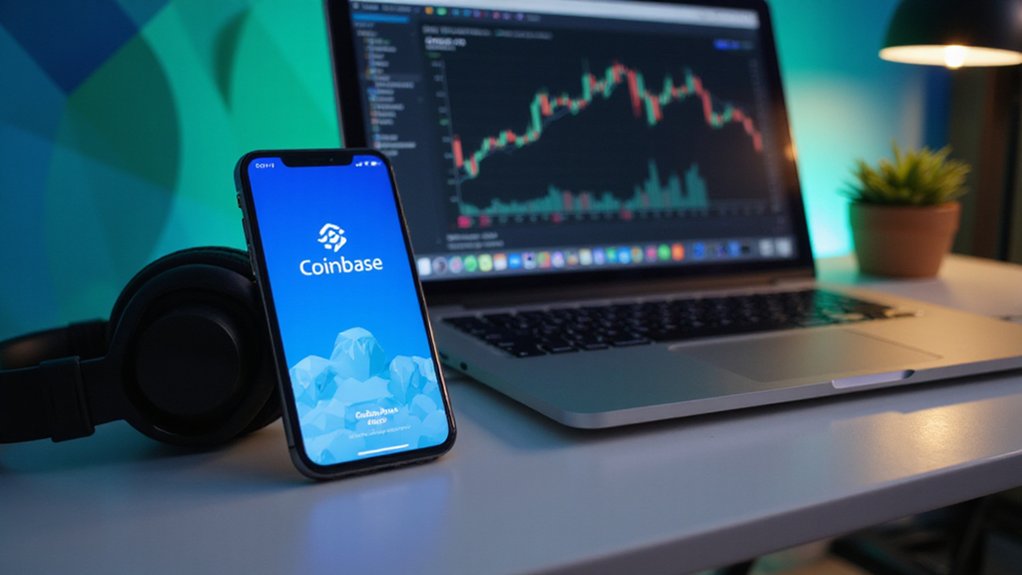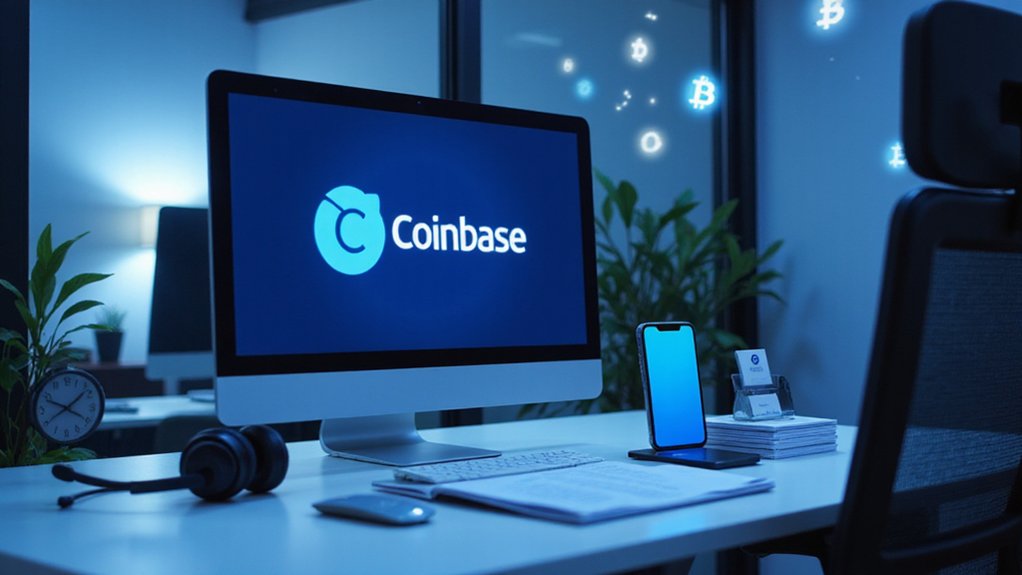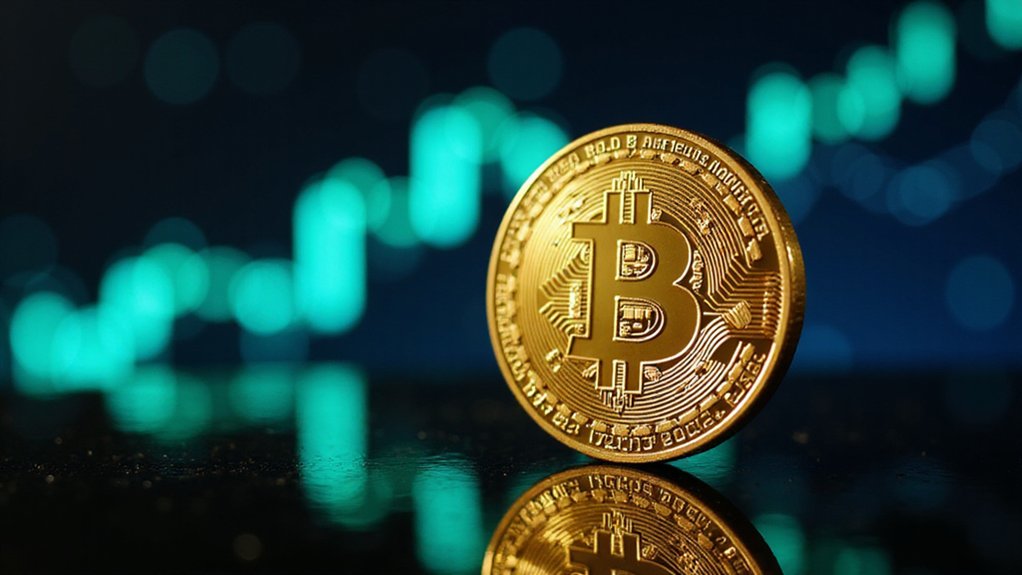Coinbase offers multiple support channels including 24/7 chat, phone assistance, and email support for account issues. Users must sign into their accounts, select the relevant category for their problem, and then access the “Contact Us” option. The platform handles queries ranging from account management to security concerns, with a formal complaint process requiring an existing support case number. Response effectiveness may vary during market volatility—a phenomenon seasoned crypto enthusiasts have come to expect with stoic resignation. Further exploration reveals additional regulatory resources worth investigating.

When traversing the often labyrinthine world of cryptocurrency exchanges, knowing how to reach customer support becomes nothing short of essential.
Coinbase—that behemoth of digital asset platforms—offers multiple channels through which the beleaguered user might seek assistance, though effectiveness varies with market volatility (curious how support availability seems inversely proportional to bitcoin price movements).
Coinbase provides 24/7 support through both chat and phone channels—a relative luxury in an industry where “customer service” often appears to be an afterthought rather than a priority.
In an industry where support feels optional, Coinbase’s 24/7 chat and phone assistance stands as a rare acknowledgment that customers matter.
Users experiencing the peculiar anguish of being unable to access their accounts can utilize email support, while those preferring physical correspondence may direct mail to Coinbase‘s New York address during standard business hours—though one wonders about the efficiency of postal communication for digital currency issues.
Accessing support typically requires users to sign into their Coinbase accounts first—a catch-22 that hasn’t escaped notice among those locked out of their holdings.
Once authenticated, users must select a relevant category describing their predicament before the coveted “Contact Us” option materializes.
The support portal also allows users to request calls, though increased volume often translates to extended wait times (what else would one expect during a bull run?).
Unlike MetaMask which requires users to manually store seed phrases for wallet recovery, Coinbase manages key security on behalf of its users while still providing account recovery options.
Common queries addressed by Coinbase support include account management difficulties, payment method configurations, suspicious activity concerns, trading issues, and security matters.
For more formal grievances, Coinbase maintains a structured complaint process requiring an existing support case number, with responses promised within 15 business days—a timeframe that can feel interminable when one’s assets hang in digital limbo.
The exchange also maintains a community platform where users can share feedback and engage with others, though such forums often serve as collective lamentations rather than solution repositories.
This knowledge base, while extensive, sometimes requires the persistence of Sisyphus to locate precisely applicable information.
For regulatory matters, Coinbase provides licensing information and reminds users that virtual currency lacks traditional financial protections—a sobering footnote to the decentralized finance revolution. In certain states like Illinois, customers with unresolved issues can file complaints through the Division of Financial Institutions using their online form after first attempting to resolve the matter directly with Coinbase.
Frequently Asked Questions
What Are the Typical Verification Times for New Coinbase Accounts?
Coinbase verification timeframes exist in a curious state of quantum indeterminacy—no fixed duration can be reliably cited.
The process fluctuates based on document quality, geographical considerations, and compliance requirements.
While some fortunate souls sail through verification promptly, others languish in bureaucratic purgatory due to blurry photos, expired documentation, or the algorithmic caprice of automated systems.
Technical hiccups and high-volume periods (cryptocurrency bull runs, anyone?) further compound potential delays—a reminder that instant gratification remains elusive in financial onboarding.
How Do I Recover Funds Sent to the Wrong Wallet Address?
To recover misdirected funds, users should immediately utilize Coinbase’s asset recovery tool (coinbase.com/asset-recovery), selecting the appropriate network and providing transaction details.
Recovery likelihood hinges on destination specifics—transfers to other Coinbase accounts offer reasonable prospects, while errant transmissions to external wallets present formidable challenges.
For non-Coinbase destinations, direct recipient communication becomes essential.
Prevention remains the superior strategy; implementing address allowlisting and test transactions would forestall such financial misadventures entirely.
Why Was My Account Suddenly Restricted or Limited?
Account restrictions occur suddenly for various reasons—incomplete verification, suspicious activity patterns (those late-night crypto shopping sprees do raise eyebrows), regulatory compliance issues, or login anomalies.
Coinbase’s algorithmic sentinels remain ever-vigilant, occasionally overzealous in their protective duties.
Users should review security settings, provide requested documentation, and contact support if restrictions persist.
The financial panopticon of cryptocurrency exchanges demands both compliance and patience—a paradoxical dance of freedom and surveillance that defines modern digital asset management.
Does Coinbase Support Staking for All Cryptocurrencies?
Coinbase supports staking for only seven cryptocurrencies: Ethereum, Solana, Cosmos, Tezos, Cardano, Polkadot, and Algorand—not the entire crypto universe.
Their selective approach hinges on technical compatibility (assets must use proof-of-stake consensus) and regulatory compliance.
Yields fluctuate considerably, reaching up to 15% for higher-performing assets like Algorand and Cosmos.
Future additions remain possible as networks evolve and regulatory landscapes shift, but universal staking support remains—perhaps wisely—beyond Coinbase’s current ambitions.
What Security Measures Should I Enable to Protect My Account?
Securing one’s Coinbase account requires a layered approach—think of it as financial Fort Knox, not a garden shed.
Users should enable a security key (YubiKey preferable) for 2FA, implement unique, high-entropy passwords, and harden associated email accounts with their own 2FA protocols.
Cold storage for substantial holdings adds another prudent layer, while regular security audits (checking authorized devices and session activity) round out a robust defense against the ever-creative criminal element in the crypto space.









